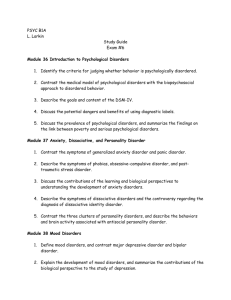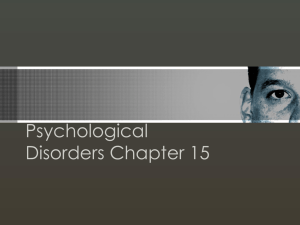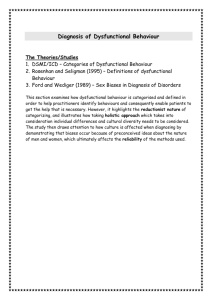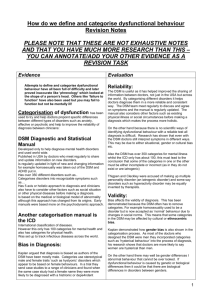Prep Guide Chapter 12: Psychological Disorders and Treatment
advertisement
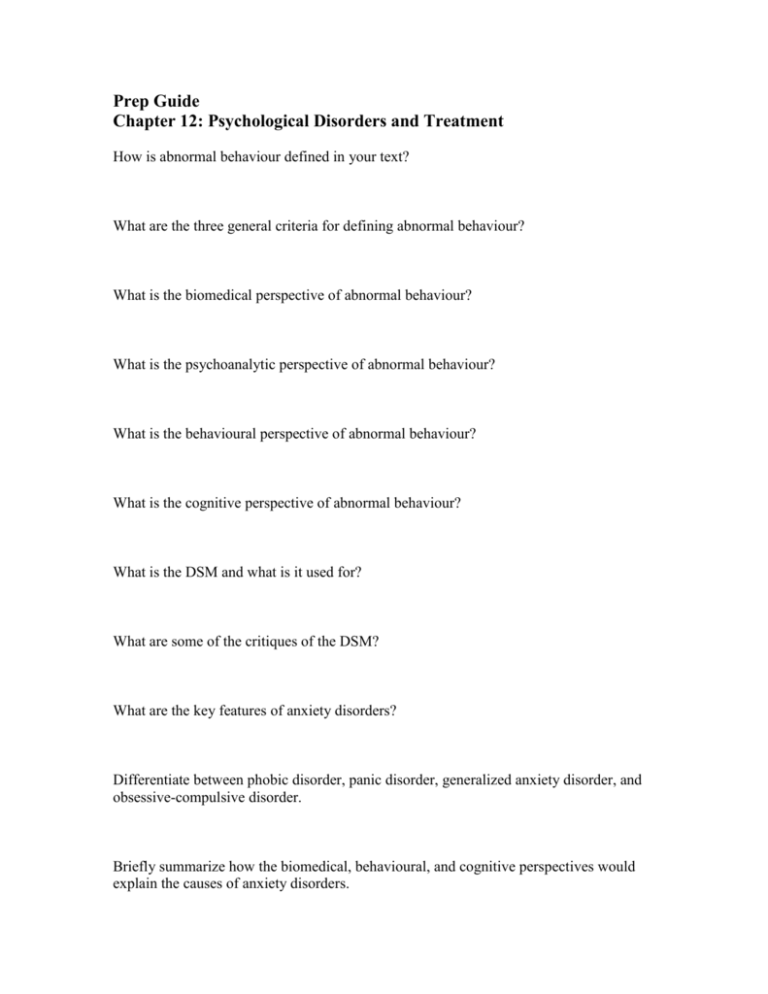
Prep Guide Chapter 12: Psychological Disorders and Treatment How is abnormal behaviour defined in your text? What are the three general criteria for defining abnormal behaviour? What is the biomedical perspective of abnormal behaviour? What is the psychoanalytic perspective of abnormal behaviour? What is the behavioural perspective of abnormal behaviour? What is the cognitive perspective of abnormal behaviour? What is the DSM and what is it used for? What are some of the critiques of the DSM? What are the key features of anxiety disorders? Differentiate between phobic disorder, panic disorder, generalized anxiety disorder, and obsessive-compulsive disorder. Briefly summarize how the biomedical, behavioural, and cognitive perspectives would explain the causes of anxiety disorders. What are mood disorders? Differentiate between major depression and bipolar disorder. Briefly summarize how the biomedical and cognitive perspectives would explain the causes of mood disorders. Why is depression diagnosed in approximately twice as many women as men? What is schizophrenia? What factors distinguish schizophrenia from other disorders? Differentiate between positive and negative symptoms of schizophrenia. What are the subtypes of schizophrenia? (Please refer to Figure 12.5) What is the “predisposition model of schizophrenia”? What are personality disorders and how are they different from the other disorders you have already learned about? Briefly discuss the key features of anti-social personality disorder. Define the key features of borderline personality disorder. Define the key features of narcissistic personality disorders. What are dissociative disorders? Briefly summarize the three dissociative disorders (dissociative amnesia, dissociative fugue, and dissociative identity disorder). How many people in the general population are likely to suffer from a psychological disorder? What is comorbidity? Briefly summarize the social and cultural context of psychological disorders. What is biomedical therapy? Briefly summarize the different drug treatments for psychological disorders (i.e., antipsychotic, antidepressants, mood stabilizers, and antianxiety drugs) and provide an example of each. Differentiate between electroconvulsive therapy (ECT) and transcranial magnetic stimulation. What is the goal of psychodynamic therapy? What is psychoanalysis and when is it used? How is contemporary psychodynamic therapy different from psychoanalysis? Why are psychodynamic techniques sometimes controversial? What is the basic principle of behavioural therapies? What is aversive conditioning? Describe the process of systematic desensitization. What is exposure therapy? How is graded exposure different from pure exposure therapy? How does the token system work? How does contingency contracting work? What disorders are best treated using behaviour therapy? What is the basic belief of the cognitive therapies? Briefly describe the cognitive-behavioural approach. Describe humanistic therapy. What is person-centred (client-centred) therapy? Evaluate the humanistic therapies. Describe interpersonal therapy (IPT). What is the goal of group and family therapies? What is spontaneous remission? Is psychotherapy effective? How is community psychology different from the previous treatments you have learned about? What symptoms might suggest that someone needs the help of a mental health professional? Now it’s time to apply your knowledge! Go to McGraw-Hill ConnectTM at www.mcgrawhillconnect.com. Check to see if your instructor has assigned any homework or posted any quizzes or tests, and then click on the LearnSmartTM study modules and complete the study module for Chapter 12. Open the eBook and view the eight videos associated with this chapter (Phobias, OCD, Depression, Biopolar, John Nash, A Beautiful Mind, ADHD, and Using Soccer as Therapy). Remember, you can highlight or add notes to your eBook (see the links at the top of your eBook) and they will automatically be saved to your “my notebook” for further study. Want more practice with the content of this chapter? Go to http://highered.mcgrawhill.com/sites/0071056742/student_view0/chapter12/ and test your knowledge using the flash cards, complete the crossword puzzle, and then see how you do on the pop quiz!







